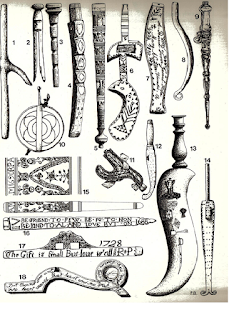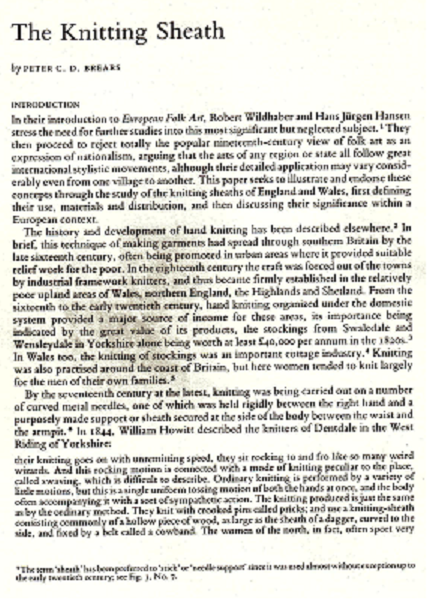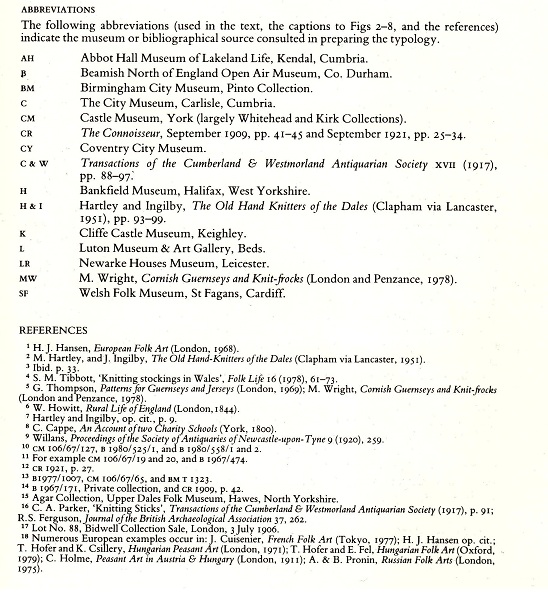When swaving, I find wear between the needle and a wooden needle adapter to be much greater than I expected. Thus, I end up using brass inserts in the needle adapter. I have already recounted that with long needles motion between the needle and needle adapter causes rapid wear. I dealt with this by devising a tapered needle adapter that minimized motion between the needle and the needle adapter. Thus, wear in knitting sheaths is a problem.
Whittlers did not have the option of the tapered needle adapter that I use, and are unlikely to use brass inserts.
Looking at Fig. 5, we see whittled knitting sheaths. Whittled chains and caged balls can only be done on soft wood. Whittlers did not have the option of the tapered needle adapter that I use, and are unlikely to use brass inserts. With the exception of no. 1, these are love tokens, and not functional knitting sheaths. However, they present some points of interest.
"Historical documentation" of No. 1 says that it was used under the arm. Likely that source was in the Victorian time frame accustomed to pit knitting, and source was not likely aware of traditions of knitting sheath use. The chain would not function in an under the arm position. The pull on the working needle would have been too great. From the drawing, it appears to me that the needle adapter is a separate piece of wood from the whittled chain. Thus, the needle adapter could have been made from a harder wood, and was replaceable so the whittled chain could be used with a series of needle adapters. It was likely hung at the waist by a cow band.
Nos. 4 & 8 hint that knitters had more than one object dangling on their right side. And Nos. 2, 4, & 8 have multiple hooks. I take this to mean that knitters had a clew to hold their yarn and a hook (with a swivel) to hold their knitting.
My guess is that functional knitting sheaths were made of harder woods, and whittled chains with hooks (at each end) were common to support clews and knitting, but did not make it into Brears, because they were not knitting sheaths per se. If we look at Fig 4., and remember that many of these are non functional love tokens,
Whittlers did not have the option of the tapered needle adapter that I use, and are unlikely to use brass inserts.
Looking at Fig. 5, we see whittled knitting sheaths. Whittled chains and caged balls can only be done on soft wood. Whittlers did not have the option of the tapered needle adapter that I use, and are unlikely to use brass inserts. With the exception of no. 1, these are love tokens, and not functional knitting sheaths. However, they present some points of interest.
"Historical documentation" of No. 1 says that it was used under the arm. Likely that source was in the Victorian time frame accustomed to pit knitting, and source was not likely aware of traditions of knitting sheath use. The chain would not function in an under the arm position. The pull on the working needle would have been too great. From the drawing, it appears to me that the needle adapter is a separate piece of wood from the whittled chain. Thus, the needle adapter could have been made from a harder wood, and was replaceable so the whittled chain could be used with a series of needle adapters. It was likely hung at the waist by a cow band.
Nos. 4 & 8 hint that knitters had more than one object dangling on their right side. And Nos. 2, 4, & 8 have multiple hooks. I take this to mean that knitters had a clew to hold their yarn and a hook (with a swivel) to hold their knitting.
My guess is that functional knitting sheaths were made of harder woods, and whittled chains with hooks (at each end) were common to support clews and knitting, but did not make it into Brears, because they were not knitting sheaths per se. If we look at Fig 4., and remember that many of these are non functional love tokens,
I think Nos. 1,8, & 9 show where hooks or cords could have been hung. Likewise, Nos. 3,4,9,10, 11,14,15, & 16 in Fig 3.
All in all, and considering Howitt's descriptions, we can expect that the old knitters had clews for yarn and hooks for knitting dangling from their knitting sheath or their belt near the knitting sheath. This works if the floor is dirty.
The clew is easy with a center pull ball or even a cone with the right kind of hook. With either a center pull ball or a cone, no swivel is required.
The spun yarns and cords that they had at that time would have tended to untwist under sustained tension with a swivel, but they needed the swivels so the knitting could turn as they knitted round and round. My guess is that knitters without a whittler just braided themselves loops or used strips of cloth or leather laces from which to hang their knitting. Without a swivel, all of these get twisted up and tangled. Note that Fig. 5 No. 6 does not have a swivel in it. Note that the 4 swivels in No. 8 are not functional.
Actually for big knitting, I like loops of braided nylon cord with a swivel from my fishing gear and one of those big safety pins that they sell for holding stitches. I fold the knitting up into a compact package. I put a loop of cord through the bottom of the sheath, the swivel, another loop of cord, and the stitch holder. Then the stitch holder holds the knitting.









.jpg)